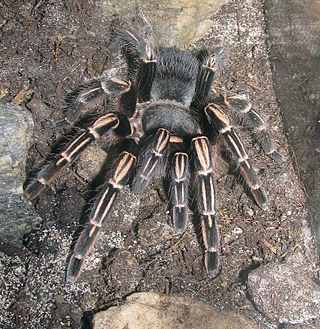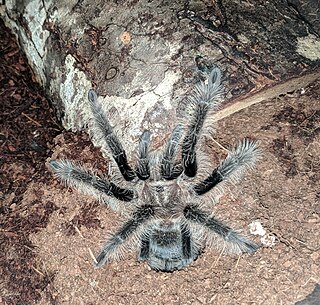
A spinneret is a silk-spinning organ of a spider or the larva of an insect. Some adult insects also have spinnerets, such as those borne on the forelegs of Embioptera. Spinnerets are usually on the underside of a spider's opisthosoma, and are typically segmented. While most spiders have six spinnerets, some have two, four, or eight. They can move both independently and in concert.

The Goliath birdeater belongs to the tarantula family Theraphosidae. Found in northern South America, it is the largest spider in the world by mass and body length, and second to the giant huntsman spider by leg span. It is also called the Goliath tarantula or Goliath bird-eating spider; the practice of calling theraphosids "bird-eating" derives from an early 18th-century copper engraving by Maria Sibylla Merian that shows one eating a hummingbird. Despite the spider's name, it rarely preys on birds.

The Chilean rose tarantula, also known as the rose hair tarantula, the Chilean fire tarantula, or the Chilean red-haired tarantula, is probably the most common species of tarantula available in American and European pet stores today, due to the large number of wild-caught specimens exported cheaply from their native Chile into the pet trade. The species is also known from Bolivia and Argentina.

Brachypelma is a genus of spiders in the family Theraphosidae (tarantulas). They may have bodies up to 6 cm long with legs of similar or greater lengths. Some species have brightly colored legs, with red or orange marks and rings.

Aphonopelma is a genus of tarantulas native to the Americas. It includes nearly all the North American tarantula species north of Mexico and a considerable percentage of the tarantula species that range into Central America. Most are fairly large tarantulas with leg spans of 6 in (16 cm) or more. Like most New World tarantulas, all species of Aphonopelma have urticating hairs. Despite their fearsome appearance, these tarantulas are not harmful to humans and some species are popular in the pet trade. With about 90 species described so far, Aphonopelma comprises about 10% of the total number of described tarantula species. However, their taxonomy is poorly understood and species are difficult to tell apart, especially those that are brown or black without other pattern. Therefore, the actual number of species is unknown, with more species likely to be identified in the near future. In captivity, they are usually fed crickets; in the wild, they eat most insects, including crickets, grasshoppers, cockroaches, mantises, and beetles.

Avicularia avicularia, sometimes called the pinktoe tarantula, is a species of tarantula native from Venezuela, Guyana, Suriname, French Guiana and Trinidad and Tobago to Peru, Bolivia and Brazil. This species is sometimes called the Guyana pinktoe, or South American pinktoe.

Lasiodora parahybana, the Brazilian salmon pink bird-eating tarantula, also simply known as the salmon pink or LP, is a tarantula from north-eastern Brazil and considered to be the fourth largest tarantula in the world.

Chromatopelma is a monotypic genus of South American tarantulas containing the single species, Chromatopelma cyaneopubescens. Commonly known as greenbottle blue tarantulas due to their metallic blue legs and blue-green carapace, they are very active and fast-growing tarantulas that are particularly attractive to hobbyists. They are native to the Paraguaná Peninsula.

Chiasmocleis ventrimaculata, also known as the dotted humming frog, is a species of frog in the family Microhylidae. It is found in Bolivia, Brazil, Colombia, Ecuador, and Peru. Its natural habitats are subtropical or tropical moist lowland forests, swamps, and intermittent freshwater marshes.

Aphonopelma chalcodes, commonly known as the western desert tarantula, desert blonde tarantula, Arizona blonde tarantula or Mexican blonde tarantula, is a species of spider belonging to the family Theraphosidae. It has a limited distribution in the deserts of Arizona and adjacent parts of Mexico but can be very common within this range. The common name "blonde tarantula" refers to the carapace, which is densely covered in pale hairs, and contrasts strongly with the all-dark legs and abdomen. Additionally, these spiders have low toxicity, a long life expectancy, and several offspring.

Davus fasciatus, commonly known as the Costa Rican tiger rump, is a species of a new-world tarantula native to Costa Rica. This is a terrestrial species with a maximum legspan of 12 centimetres (4.7 in), which makes it a rather small tarantula species, yet it is one of the largest of its genus.

Tliltocatl albopilosus is a species of tarantula, also known as the curlyhair tarantula. The species' native range is Nicaragua and Costa Rica. They are largely terrestrial, opportunistically burrowing spiders.

Tarantulas comprise a group of large and often hairy spiders of the family Theraphosidae. As of December 2023, 1,100 species have been identified, with 166 genera. The term "tarantula" is usually used to describe members of the family Theraphosidae, although many other members of the same infraorder (Mygalomorphae) are commonly referred to as "tarantulas" or "false tarantulas". Some of the more common species have become popular in the exotic pet trade. Many New World species kept as pets have setae known as urticating hairs that can cause irritation to the skin, and in extreme cases, cause damage to the eyes.

The Aphonopelma hentzi, also known as Texas brown tarantula, Oklahoma brown tarantula, or Missouri tarantula, is one of the most common species of tarantula living in the Southern United States today. Texas brown tarantulas can grow to leg spans in excess of 10 cm (4 in), and weigh more than 85 g (3 oz) as adults. Their bodies are dark brown, though shades may vary between individual tarantulas. The colors are more distinct after a molt, as with many arthropods.

Brachypelma albiceps is a species of spider in the tarantula family, Theraphosidae. It is known as the Mexican golden red rump tarantula or the Amula red rump tarantula. The carapace is a light golden color and the abdomen dark, covered with long red hairs. Females typically live for about 15 years. Males usually live about 5 years or up to 12 months after the last molt.

Aphonopelma anax, commonly known as the Texas tan tarantula, is a species of spider belonging to the family Theraphosidae native to southern Texas and northern Mexico.

Aphonopelma iodius is a species of spider in the tarantula family Theraphosidae, found in United States. A 1997 paper combined it with three other previously described species into a single species, calling it "A. iodium". However, iodius is a neuter comparative adjective and is the correct form. Aphonopelma smithii has also been synonymized with A. iodius. A. iodius is common in the Mojave Desert to the west of the Colorado River.

Aphonopelma moderatum is a species of spider in the family Theraphosidae, found in United States, in the state of Texas. Commonly called the Rio Grande Gold Tarantula as they are found in the Rio Grande Valley of Texas.
Sandinista lanceolatum is a species of spider in the family Theraphosidae (tarantulas), native to Nicaragua and Costa Rica.

Tapinauchenius plumipes, the orange tree spider, is a tarantula endemic to French Guiana. It was first described by Ludovico Di Caporiacco in 1954. Its previous name, Tapinauchenius gigas was based on the Latin word for giant, being gigas. This tarantula is often kept as a pet and commonly bred.




















